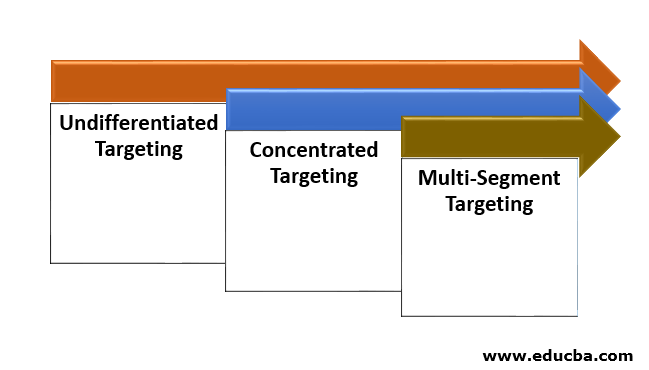Introduction to Market Segmentation and Targeting
The following article provides an outline for Market Segmentation and Targeting. Segmentation is the process of classifying the market and the target audience on the basis of different factors like different types of consumers, homogeneity, distinctiveness, commonalities between them, their attitude, social strata, demographic factors like age, family size, marital status, gender, and many other factors. Market segmentation business is a pedestal for the market research and the success of any business. Market segmentation helps to segregate the consumer market, which helps the marketing team in planning and organizing the marketing campaign. The target market includes the market segments which are profitable to both the consumers and the company.
Market segmentation and target marketing both serve as a very useful technique in saving time, money, and efforts engaged in marketing the product/services as targeted marketing focuses on targeting the consumers or audience as per different consumer habits. It is important to understand that if the market is not studied in advance and the marketers don’t focus on the targeted market, the effect of marketing is diluted, and the company or the marketers tend to spend unnecessary time, money, and resources on the group of the non-profitable consumer markets.
Marketers and the company use market segmentation and targeting practices to create a competitive and profitable market with a higher rate of success and minimal risks of loss. A deeper understanding of the target market and targeted consumers assist the marketers in designing, developing, organizing, and promote products in a more efficient and effective manner and helps to gain the trust of the consumers in the market.
Segmentation-Target-Positioning Approach to Business
This approach of selecting the target audience/target market is basically termed the STP process (Segmentation-Target-Positioning process). According to the STP approach of business, Market segmentation is the first step of the marketing campaigns. Market segmentation refers to the splitting of market and consumer based on their commonalities and homogeneity.
These commonalities and homogeneity include different factors like geographic factors (location, country, region, and weather), demographic factors (age, family size, gender, etc.), and the attitude of the consumer towards purchasing the product/services, the sensitivity of the consumers towards the product/services price factor. Market segmentation involves identifying the TAM (Total available market) for the business and different sub-categories of the consumers. Market segmentation allows the business to streamline its marketing activities and cater to the consumer needs, wants, and aspirations with a higher satisfaction rate, which in return helps the business save huge amounts of money and time and marketing efforts of the resources. Once the market has been studied carefully, the next step is to identify the target market or the target audience for selling the products and services.
Targeting helps the marketers to understand and cater to the needs of the consumers and thus helps to design and develop the marketing strategy and tactics in a highly organized manner keeping maximum profit in mind.
Factors that help in selecting the target market/target audience:
- Consumer needs and aspirations.
- Size of the available market and the growth rate of the market.
- Segment structural attractiveness.
- Objectives and resources are available to cater to the targeted audience.
- Identifying the business proximity, i.e. the distance of the target audience from the business.
- Sales, spend and purchase the pattern of the consumers, i.e. how much the consumer/buyer spends and their attitude towards purchasing the product/services.
Targeting also helps to accumulate more accurate and precise data about the consumer aspirations, wants, needs, demands, behavior, and attitude towards the product/services, which helps narrow the consumer market. In simple words, targeting helps to refine the market and consumer needs. Positioning refers to the design and development of a position for each market. Thus, before positioning a product or a market strategy in the market, the marketing team must ensure that the market has been segmented properly and the marketing strategy is developed as per the consumer’s aspiration, which will benefit both the consumer and the company.
Need for Target Marketing
Target marketing aims to cut down the costs because the resources and efforts are not wasted on broadcasting or reaching and pleasing everyone; instead, selected sections of the consumers are approached who feature the tendency to consume or buy the product and services. Thus, targeting helps to increase business revenue by targeting the right consumers. Target marketing thus aims at investing marketing efforts at a particular segment of consumers making the marketing, promotion, pricing of the products/services easier in a cost-efficient manner.
Categories
Below mentioned are three approaches/strategies to select the target market:
1. Undifferentiated Targeting
As the name itself is self-explanatory, undifferentiated targeting is selecting the market or audience in generic under a single marketing strategy. In undifferentiated targeting whole market is targeted, and a single product is sold to the whole market without any customization. Thus, this targeting strategy is less competitive and benefits those businesses in which consumers don’t bother about the standardized products and are concerned with the low costs. It benefits the company or the business as the production cost is low under this targeting strategy.
2. Concentrated Targeting
Concentrated targeting approaches or is concentrated for a specific market, and the marketing efforts are targeted onto this particular market. This approach helps to narrow the consumers and thus guides in catering to the needs of the consumers in a more effective and organized way. It helps small businesses to focus on consumers of a particular section as compared to the larger firms and helps them to establish their brand among a particular segment of the market.
3. Multi-Segment Targeting
This approach of targeting is well suited for companies that plan to target more than one market at a time. Multi-segment targeting allows the business to reach a bigger population, but it costs expensive to the company. This approach requires more management and efforts to be invested as it targets a larger section of the population. Marketing is very essential for a successful business and o to reach out to more and the number of consumers. It is extremely important to follow the right approach of reaching out to consumers by selecting the correct and appropriate target market for promoting the business.
Recommended Articles
This is a guide to Market Segmentation and Targeting. Here we discuss the Segmentation-Target-Positioning Approach of Business along with the need and categories of target marketing. You may also look at the following articles to learn more–





